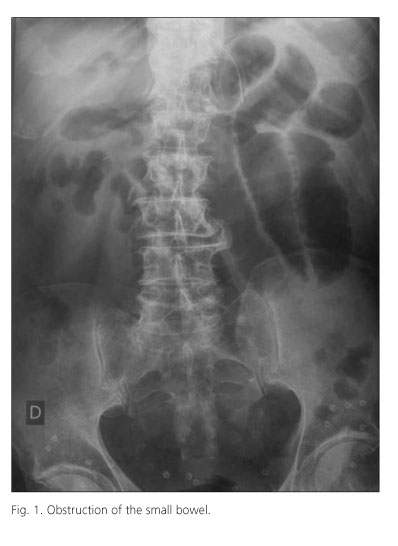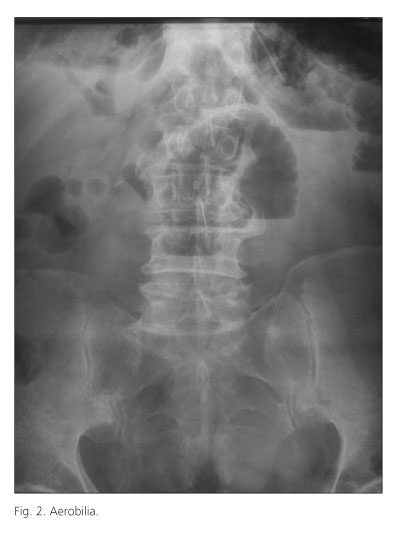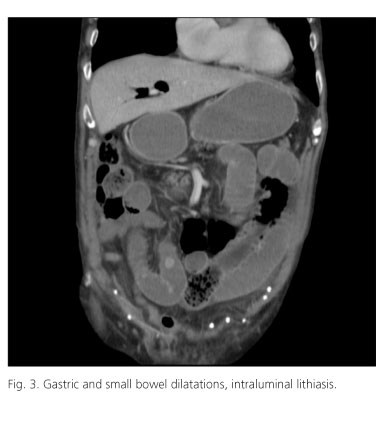My SciELO
Services on Demand
Journal
Article
Indicators
-
 Cited by SciELO
Cited by SciELO -
 Access statistics
Access statistics
Related links
-
 Cited by Google
Cited by Google -
 Similars in
SciELO
Similars in
SciELO -
 Similars in Google
Similars in Google
Share
Revista Española de Enfermedades Digestivas
Print version ISSN 1130-0108
Rev. esp. enferm. dig. vol.103 n.8 Madrid Aug. 2011
https://dx.doi.org/10.4321/S1130-01082011000800008
PICTURES IN DIGESTIVE PATHOLOGY
Small bowel obstruction after ERCP
Obstrucción intestinal completa tras CPRE
M.a Antonia Montenegro1, José Ignacio Blanco2, Miguel Toledano3, Javier Sánchez3, Juan Carlos Martín3 and Manuel Pérez-Miranda4
1Department of General Surgery A. Hospital Clínico Universitario. Valladolid, Spain.
2Department of General Surgery. Hospital Universitario Río Hortega. Valladolid, Spain.
3Department of General Surgery. Hospital Medina del Campo. Valladolid, Spain.
4Department of Digestive Diseases. Hospital Universitario Río Hortega. Valladolid, Spain
Endoscopic retrograde cholangiopancreatography (ERCP) with endoscopic sphincterotomy is the treatment of choice for common bile duct (CBD) stones. The complication rate is 5-10% with a mortality rate between 0.5-1.0%.
Post-ERCP complications are usually apparent within three days of the procedure, and rarely present after the 12th day. Pancreatitis and bleeding are the most common complication. Gallstone ileus after ERCP with CBD removal is exceedingly rare.
Case report
A 66 years old male was admitted for cholangitis with obstructive jaundice. Transabdominal US showed cholelithiasis with a 20 mm CBD compatible with choledocholithiasis. He had a history of bilateral inguinal hernia repair, appendectomy and pyloroplasty.
At ERCP a prior small sphincterotomy was enlarged, the papilla was balloon dilated, and all 12 stones found (largest diameter, 25 mm) were removed from the CBD.
After ERCP the patient had bilious vomiting with dilated small bowel loops on abdominal X ray and aerobilia (Figs. 1 and 2). Abdominal CT on day 10 showed a dilated stomach and jejunal loops, with a stone lodged inside the lumen at the terminal ileum (Fig. 3). Emergent laparoscopic surgery was undertaken, where adhesions were found in the left inguinal area, with dilated and torqued small bowel loops. The adhesions were cut, freeing the bowel loop, and cholecystectomy was carried out.
Discussion
Prolonged ERCP with insufflation estimated at over 6 liters of room air in the setting of prior adhesions, triggered in this case small bowel obstruction. This unusual complication has not been reported before. Use of carbon dioxide instead of room air, as it is done in laparoscopy, may prevent this complication in the future.
References
1. Pittman MA, Health D, McNair A. Gallstone ileus following endoscopic retrograde colangiopancreatography and endoscopic sphincterotomy. Dig Dis Sci 2007;52:513-5. [ Links ]
2. Andrabi SIH, Ahmad J, Ahmed M, Yousaf M. Gallstone ileus and bowel perforation: a rare complication of therapeutic ERCP. J Pak Med Assoc 2007;57:375-7. [ Links ]
3. Goyal A, Srivastava A. Gallstone ileus following endoscopic retrograde cholangiopancreatography and sphincterotomy: a case report. Journal of Medical Case Reports 2008;2:342. [ Links ]
4. Dellon ES, Velayudham A, Clarke BW, Isaacs KL, Gangorosa LM, Galanko JA, et al. A randomized, controlled, double-blind trial of air insufflation versus carbon dioxide insufflation during ERCP. Gastrointest Endosc 2010;72(1):68-77. [ Links ]

















